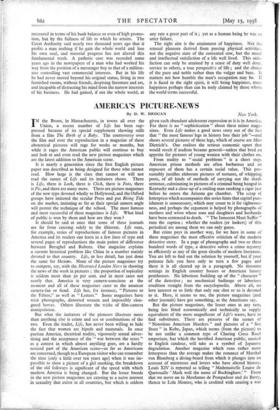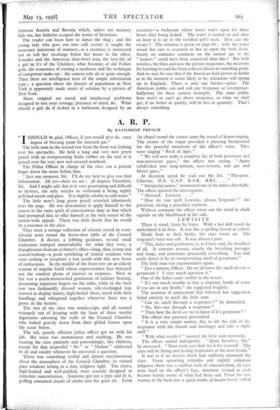AMERICA'S PICTURE-NEWS
IN the Bronx, in Massachusetts, in towns all over the Union, a recent number of Life has been sup- pressed because of its special supplement showing stills from a film The Birth of a Baby. The controversy over the film and over the reproduction in a magazine of these obstetrical pictures will rage for weeks or months, but while it rages the American public will continue to buy and look at and even read the new picture magazines which are the latest addition to the American scene.
It is nearly a generation since the first English picture paper was described as being designed for those who cannot read. How large is the class that cannot or will not read the career of Life and its imitators shows. There is Life, there is Look, there is Click, there is Foto, there is Pic, and there are many more. There are picture magazines of the new type devoted wholly to Hollywood, and the Oxford groups have imitated the secular Press and put Rising Tide on the market, imitating as far as their special camera angle will permit the technique of the school. The most famous and most successful of these magazines is Life. What kind of public is won by them and how are they won ?
It should be said at once that some of these journals are far from catering solely to the illiterate. Life runs, for example, series of reproductions of famous pictures in America and its readers can learn in a few lines of type and several pages of reproductions the main points of difference between Breughel' and Rubens. One magazine explains a current historical problem like China in a number mainly devoted to that country. Life, in less detail, has just done the same for Mexieo. None of the picture magazines try to compete, say, with the Illustrated London News in showing the news of the week in pictures ; the proportion of topicality is seldom more than 5o per cent. and in most 'cases not nearly that. America is very camera-conscious at the moment and all of these magazines cater to the amateur camera-fan or fiend. Life has, for instance, " Pictures to the Editor," as well as. " Letters." Some magazines have trick photographs, distorted women and impossibly elon- gated horses. Others illustrate the tricks of film-camera manipulation.
'But what the imitators of the pioneers illustrate more than anything else is crime and sex or combinations of the two. Even the leader, Life, has never been willing to hide the fact that women are bipeds and mammals. In once puritan America, theatrical nudity, vigorously sexual adver- tising and the acceptance of the " war between the sexes " as a contest in which almost anything goes, are a hardly noticed part of the American scene—as far as Americans are concerned, though to a European visitor who can remember the time (only a little over ten years ago) when it was im- possible to show a picture of a girl smoking, the breakdown of the old folkways is significant of the speed with which modern America is being changed. But the lesser breeds in the new picture magazines are catering to a naive interest in sexuality that exists in all countries, but which is seldom given such abundant adolescent expression as it is in America. For there is no " sophistication " about these minor maga- zines. Even Life makes a good news story out of the fact that " the most famous' egs in history lose their job "—and shows several pictures of these legs, which of course are Miss Dietrich's. One realises the serious economic upset that would result if nudism became general—unless that bred art appetite for pictures of young women with their clothes on.
From nudity to " social problems " is a short step. American prison methods are often barbarous and an exposure of them has a certain social value. This pre- sumably justifies elaborate pictures of tortures, of whipping posts, of all kinds of methods of carrying out the death sentence, culminating in pictures of a criminal being hanged in Kentucky and a close-up of a smiling man smoking a cigar just before he enters the Arizona gas chamber. The scrap of letterpress which accompanies this series hints that capital pun- ishment is unnecessary, which may count to it for righteous- ness, and perhaps the argument is helped by photographs of mothers and wives whose sons and daughters and husbands have been sentenced to death. " The Innocent Must Suffer " runs the caption ; whether the readers (or lookers) of this periodical are among them we can only guess.
But crime pays' in another way, for we have in some of these magazines the most effective criticism of the modern detective story. In a page of photographs and two or three hundred words of type, a detective solves a crime mystery as efficiently as any of the great sleuths of modern literature. You are left to find out the solution by yourself, but if your patience fails you have only to turn a few pages and there it is all cleared up in a paragraph. No tiresome settings in English country houses or American luxury penthouses. No laborious building up of the " character " of the detective ; no mechanical badinage or laborious erudition straight from the encyclopaedia. Above all, no love interest or so little that only one shot or so is devoted to it. Here, it seems to me, the picture magazines (and other journals) have got something, as the Americans say.
But the picture magazines, the lesser ones at any rate, being less fitted economically and technically . to supply equivalents of the more magnificent of Life's wares, have to find substitutes. There are pictures of the scenes of " Notorious American Murders " and pictures of a " Sex Store " in Kobe, Japan, which seems (from the picture) to be not unlike a common type of Charing Cross Road emporium, but which the horrified American public, unused to English candour, will take as a symbol of Japanese degradation. Another magazine which runs rather more letterpress than the average makes the romance of Marshal von Blomberg a diving-board from which it plunges into an account of mistresses and lovers who have altered history. Louis XIV is reported as telling " Mademoiselle Louise de Queroualle ' Mark well the name of Buckingham' " From that we move on to Mesdames de Pompadour and du Barry, thence to Lola Montez, who is credited with causing a war between Austria and Bavaria which, unless my memory fails me, has hitherto escaped the notice of historians.
The reader can learn how to dance the shag ; and the young lady who goes out into café society is taught the necessary minimum of manners, as a secretary is instructed not to roll her stockings below her knees in the office. Lourdes and the American dust-bowl area, the love-life of a girl in Ur of the Chaldees, what becomes of old Follies girls, the economics of owning a racehorse and the technique of competent make-up : the camera tells all or quite enough. Then there are intelligence tests of the simple information type ; a question about the density of population in New York is apparently made easier of solution by a picture of New York.
More original are moral and intellectual problems designed to test your courage, presence of mind, &c. What should a girl do if locked in a bathroom designed by an eccentric—a bathroom whose doors won't open for three hours after being locked. The water is turned on and after an hour it is up to the terrified girl's neck. How can she escape ? The solution is given on page 66 ; with the water round her ears it occurred to her to open the bath drain. Surely no unkinder comment on the mental age of the " lookers " could have been conceived than this ? But with wireless, the films and now the picture magazines, the necessity for learning to read has been reduced almost to vanishing point. And we may be sure that if the American field proves as fertile as at the moment it seems likely to be, imitations will spring up in England. There is only one barrier—price. The American public can and will pay fivepence or sevenpence- halfpenny for these camera triumphs. The same public here won't or can't go above twopence, so, what we shall get, if no better in quality, will be less in quantity. That's always something.















































 Previous page
Previous page